Building stackable sawhorses
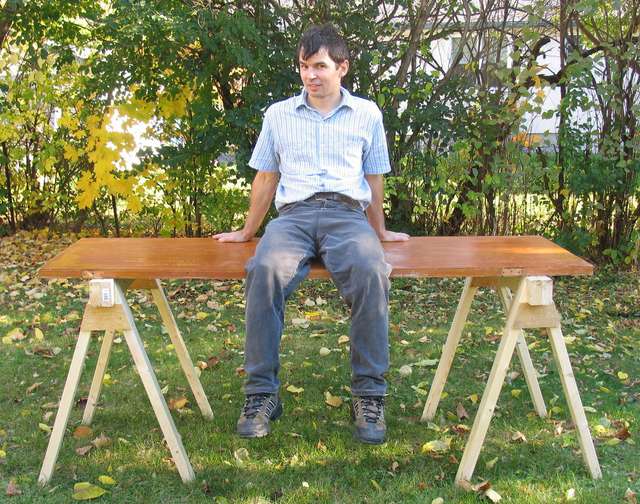
There seems to be as many variations on sawhorse designs as there are woodworkers. So it should only figure that I would have a sawhorse design of my own too.
Though really, it's not much of a design. Just as simple and sturdy a sawhorse that I could come up with. The emphasis being on light, sturdy, and stackable. Disassemble-able would be nice too, but that would compromise the other factors, and at that point, its probably better to just buy one of many types of sawhorse brackets and use those.
The only tool you need to build these is a sliding miter saw, or a radial arm saw. I used a radial arm saw, because that's what I have. I would recommend you buy a sliding miter saw instead. The way a radial arm saw pulls itself into the wood and with the saw blade coming towards you, is ideally suited for having horrific accidents with. Miter saws are much safer, and can do nearly anything practical that you could do with a radial arm saw.
Materials needed for two sawhorses
| Quantity | Item | Purpose |
| 3 | 2"x3"x8' | Legs. You can cut 3 leg segments from each 2"x3"x8' |
| 2 | 2"x4"x7' | For cross beams. |
| 1 | 3.5"x2'x.75" ply | Piece of plywood scrap to cut for leg braces |
| 12 | 2.5" nail | To nail cross beams together |
| 50 | 2" nail | To nail legs and cross braces |
Sawhorse Construction
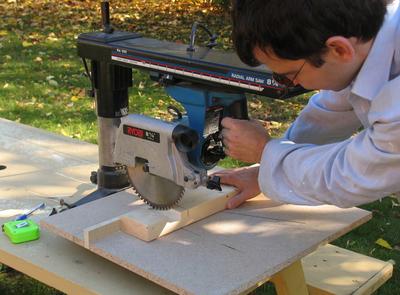 The cross beams on top of the sawhorses consist of two 2x4's 3 foot in length.
Cut the slots to a depth of half way (.75"), and 3" from the end. Measure
the width of the legs for how wide to cut this. Having the legs fit precisely
into the slot is key to having a rigid sawhorse.
The cross beams on top of the sawhorses consist of two 2x4's 3 foot in length.
Cut the slots to a depth of half way (.75"), and 3" from the end. Measure
the width of the legs for how wide to cut this. Having the legs fit precisely
into the slot is key to having a rigid sawhorse.
Its best to remove the material by making a whole series of closely spaced cuts. Quicker than chiseling out the wood that remains afterwards.
If you are using a sliding miter saw, you will need to put a 2" wide spacer behind the work piece, as the center of the saw's blade never goes as far back as the fence. So when making less than full depth cuts, to keep the cut the same depth front to back, you need a spacer behind the work piece.
If your miter saw is a non-sliding type miter saw, you will need to think up
some other way of cutting these slots, such as with a table saw or a skillsaw.
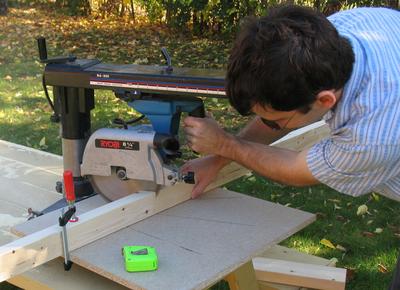 Cut the 2x2"x8' into three equal segments. At 8', this allows for three segments
32" long. I cut these mitered first, although its probably easier to cut them
square first, as I suggest in the plans.
Cut the 2x2"x8' into three equal segments. At 8', this allows for three segments
32" long. I cut these mitered first, although its probably easier to cut them
square first, as I suggest in the plans.
With the legs being only 2x3", as opposed to 2x4", its possible to cut the miters upright, as shown. The miters are all 18 degrees. Saws typically have a detent at 22.5 degrees. I was tempted to use that, but it results in the legs being a little too wide. An 18 degree detent would be used for making a 10 sided frame, so some miter saws may have a detent at 18 degrees.
Cut the legs to 32" in length. That way, you can get 3 pieces out of an 8' stud,
and can make 8 legs for two sawhorses from three 8' studs.
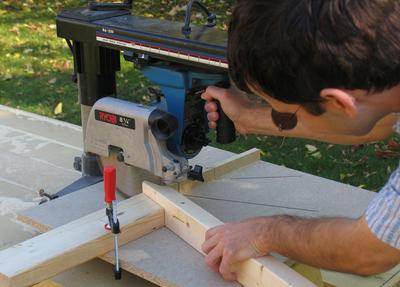 To cut the 18 degree taper in the end of the leg, I cut off a piece of scrap 2x4
with an 18 degree angle, and then used that as a guide, with the saw actually
set to 90 degrees.
To cut the 18 degree taper in the end of the leg, I cut off a piece of scrap 2x4
with an 18 degree angle, and then used that as a guide, with the saw actually
set to 90 degrees.
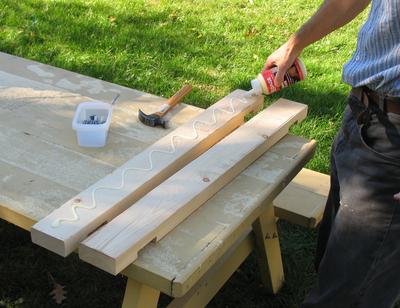 Next glue the two pieces of 2x4 that form the beam together. No need to put
a lot of glue in between, as this joint won't really get stressed.
Next glue the two pieces of 2x4 that form the beam together. No need to put
a lot of glue in between, as this joint won't really get stressed.
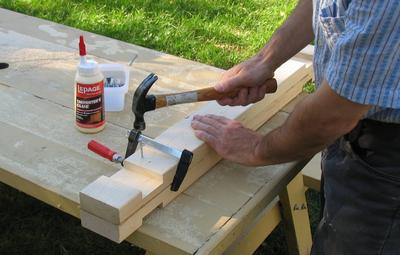 Its best to put a small clamp on the two pieces as shown before nailing them.
With the glue between the pieces, it acts as a surprisingly good lubricant,
and the pieces tend to slide out of place while you are nailing them.
Its best to put a small clamp on the two pieces as shown before nailing them.
With the glue between the pieces, it acts as a surprisingly good lubricant,
and the pieces tend to slide out of place while you are nailing them.
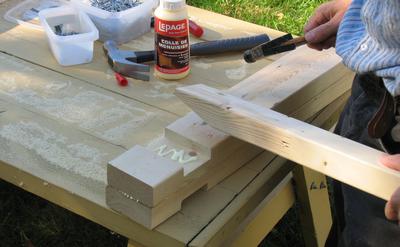 Next glue and nail the legs to the beam.
Next glue and nail the legs to the beam.
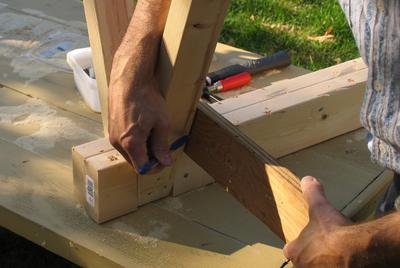 Rather than measure how big the leg plates need to be, I just marked them off the
sawhorse.
Rather than measure how big the leg plates need to be, I just marked them off the
sawhorse.
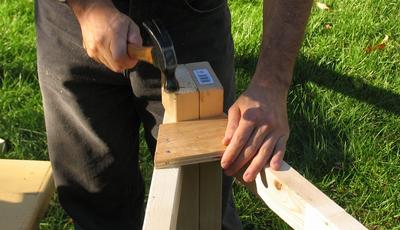 Nail the leg plates onto the legs. The leg plate should be slid right up against
the cross beam, so as to provide extra support. Nail these to both sides of the legs.
Nail the leg plates onto the legs. The leg plate should be slid right up against
the cross beam, so as to provide extra support. Nail these to both sides of the legs.
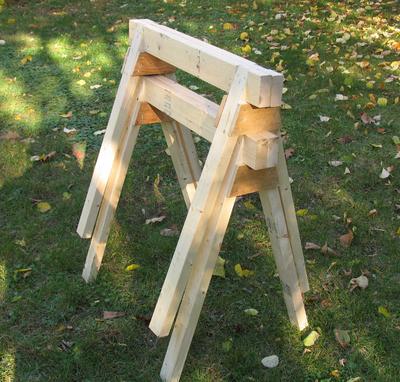 Two sawhorses done. They are Stackable.
Two sawhorses done. They are Stackable.
They also can be placed very close side by side if offset
a little bit so the legs fit behind each other.
 Two sawhorses and an old door make for a great temporary workbench. I made them 3' long,
so they'd be just wider than a door.
But use an older door, the type that has 1/4" plywood on either side, or even a solid wood
core door. New doors are a little too flimsy to use as a workbench.
You can usually get suitable doors fairly cheaply from a used buidling material store.
Two sawhorses and an old door make for a great temporary workbench. I made them 3' long,
so they'd be just wider than a door.
But use an older door, the type that has 1/4" plywood on either side, or even a solid wood
core door. New doors are a little too flimsy to use as a workbench.
You can usually get suitable doors fairly cheaply from a used buidling material store.
See also:
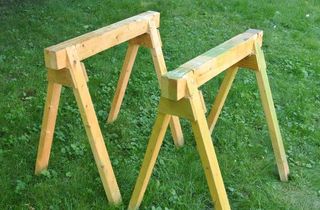 Building the sawhorses (newer article)
Building the sawhorses (newer article)
To my Woodworking website
![]()
 Sawhorse plans
Sawhorse plans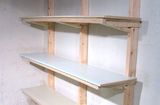 Basement shelving
Basement shelving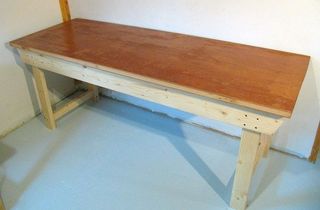 Building a workbench
Building a workbench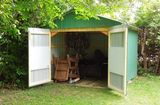 Storage shed
Storage shed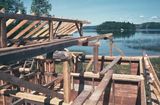 Home improvement
Home improvement